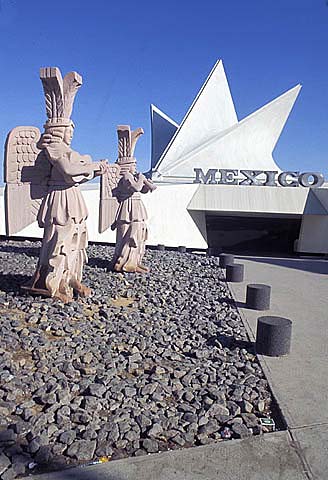
| Mexico's pavilion. |
Immediately inside the pavilion, a mural 42 feet high and 15 feet long by artist Rufino Tamayo illustrated the theme, "The Mexican and His World." It was an imposing representation of Man freeing himself from myths and constrictive nationalism, to reach out into universality.
The first hall in the pavilion presented photographs of Mexico's natural beauty, history, traditions, social progress and industrialization. Several gods of pre-Columbian mythology rose up around a model of the Piramide de Los Nichos which, with 365 alcoves studding its four sides, represented the calendar year.
The largest hall of the Mexican pavilion presented a rich collection of pre-Columbian art as well as religious and secular art objects of New Spain dating back to the 16th century. At the threshold of the hall, an Olmec prince greeted the visitor with an invitation to explore the legendary worlds of the Mayas, Toltecs and Aztecs. Nearby all the grandeur of the Mayan civilization was evoked by the life-size reconstruction of the three sacred chambers of Bonampak, discovered in the state of Chiapas in 1947.
The first hall portrayed a child prince being presented at the royal court and men preparing for war. The second hall described various phases of battles and the granting of pardon to the vanquished. And in the third hall, victory was celebrated and friendship between adversaries was renewed. Archaeologists claim that those frescos were a reliable portrayal of the customs, clothes and events of the time.
The vigorous decorations of the sacred chambers was sharply contrasted by the serene beauty of the basalt masks inlaid with mosaics and the terra-cotta funerary statuettes nearby. A gigantic column, one of eight caryatids that once supported the temple roof dedicated to the planet Venus in the sacred city of Tula, stood out among the monoliths.
After viewing a hall of pre-Hispanic art with reproductions of the Sacred Maya Chamber of Bonomark, the most ancient frescoes in the Americas, visitors proceeded to three halls that showed the art of New Spain from the 15th century to today and featured a large golden 18th century baroque altar carved by Indians. There was a modern kinetic sculpture that came to life with the slightest breeze.
 |
The Acapulco restaurant featured lively Mexican music. |
Upon exiting the main pavilion, the sound of Los Mariachis could be heard from the Acapulco bar and the adjoining Fonda Santa Anita restaurant. There, visitors could be found sipping tequila while listening to the lively and often nostalgic music of the trumpets and guitars. Here they could admire folk art decor while sampling dishes as giant shrimps in pepper sauce, red fish, or fish stuffed with almonds.